Nestle Company Financial Analysis Report: AC4410 Assignment 2
VerifiedAdded on 2023/06/03
|10
|1966
|482
Report
AI Summary
This report provides a comprehensive financial analysis of Nestle SA from 2013 to 2016, focusing on key financial ratios. The analysis begins with a company overview, highlighting Nestle's position as a global leader in the food and beverage industry, its diverse product portfolio, and its global presence...
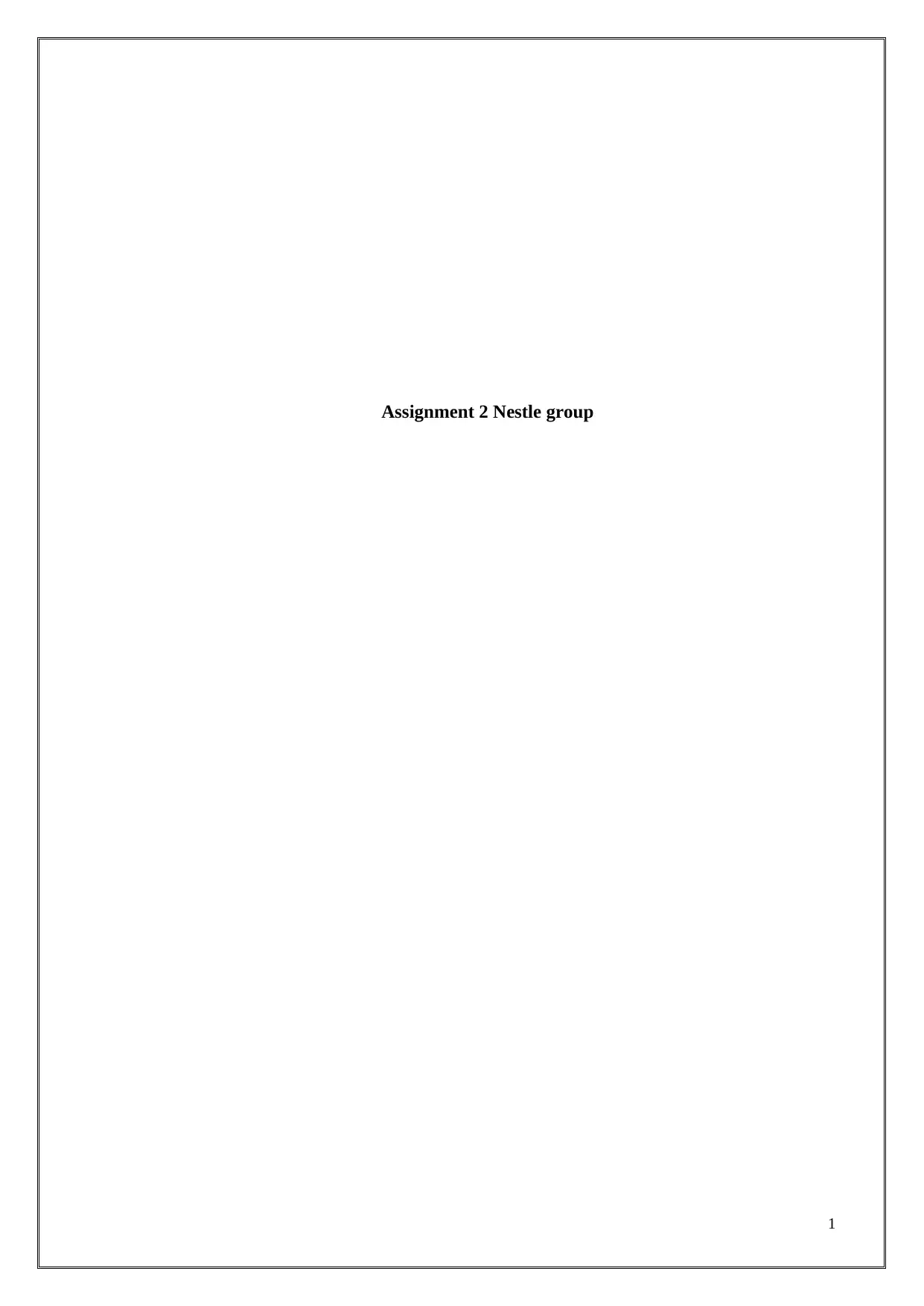
Assignment 2 Nestle group
1
1
Paraphrase This Document
Need a fresh take? Get an instant paraphrase of this document with our AI Paraphraser
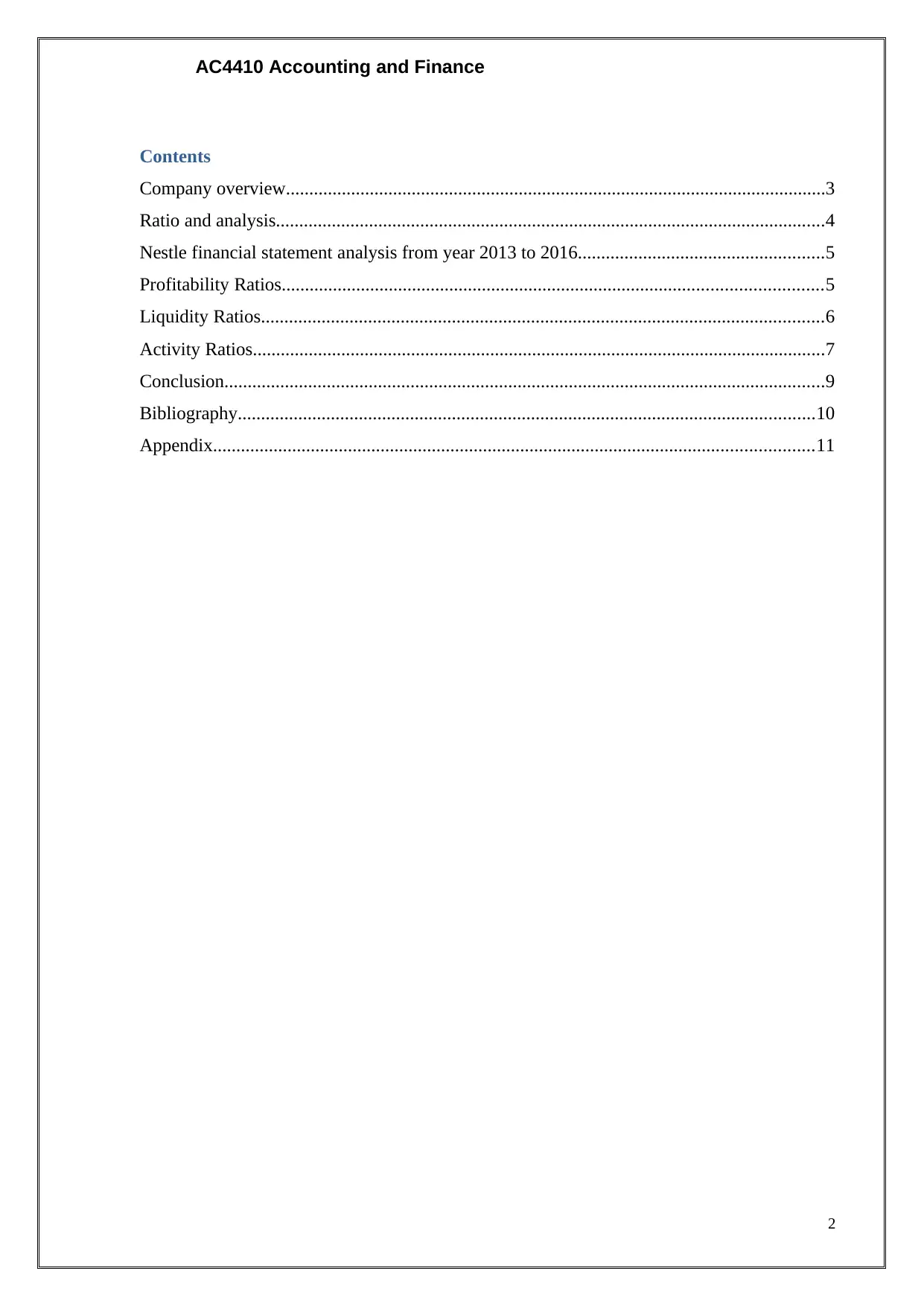
AC4410 Accounting and Finance
Contents
Company overview....................................................................................................................3
Ratio and analysis......................................................................................................................4
Nestle financial statement analysis from year 2013 to 2016.....................................................5
Profitability Ratios....................................................................................................................5
Liquidity Ratios.........................................................................................................................6
Activity Ratios...........................................................................................................................7
Conclusion.................................................................................................................................9
Bibliography............................................................................................................................10
Appendix.................................................................................................................................11
2
Contents
Company overview....................................................................................................................3
Ratio and analysis......................................................................................................................4
Nestle financial statement analysis from year 2013 to 2016.....................................................5
Profitability Ratios....................................................................................................................5
Liquidity Ratios.........................................................................................................................6
Activity Ratios...........................................................................................................................7
Conclusion.................................................................................................................................9
Bibliography............................................................................................................................10
Appendix.................................................................................................................................11
2
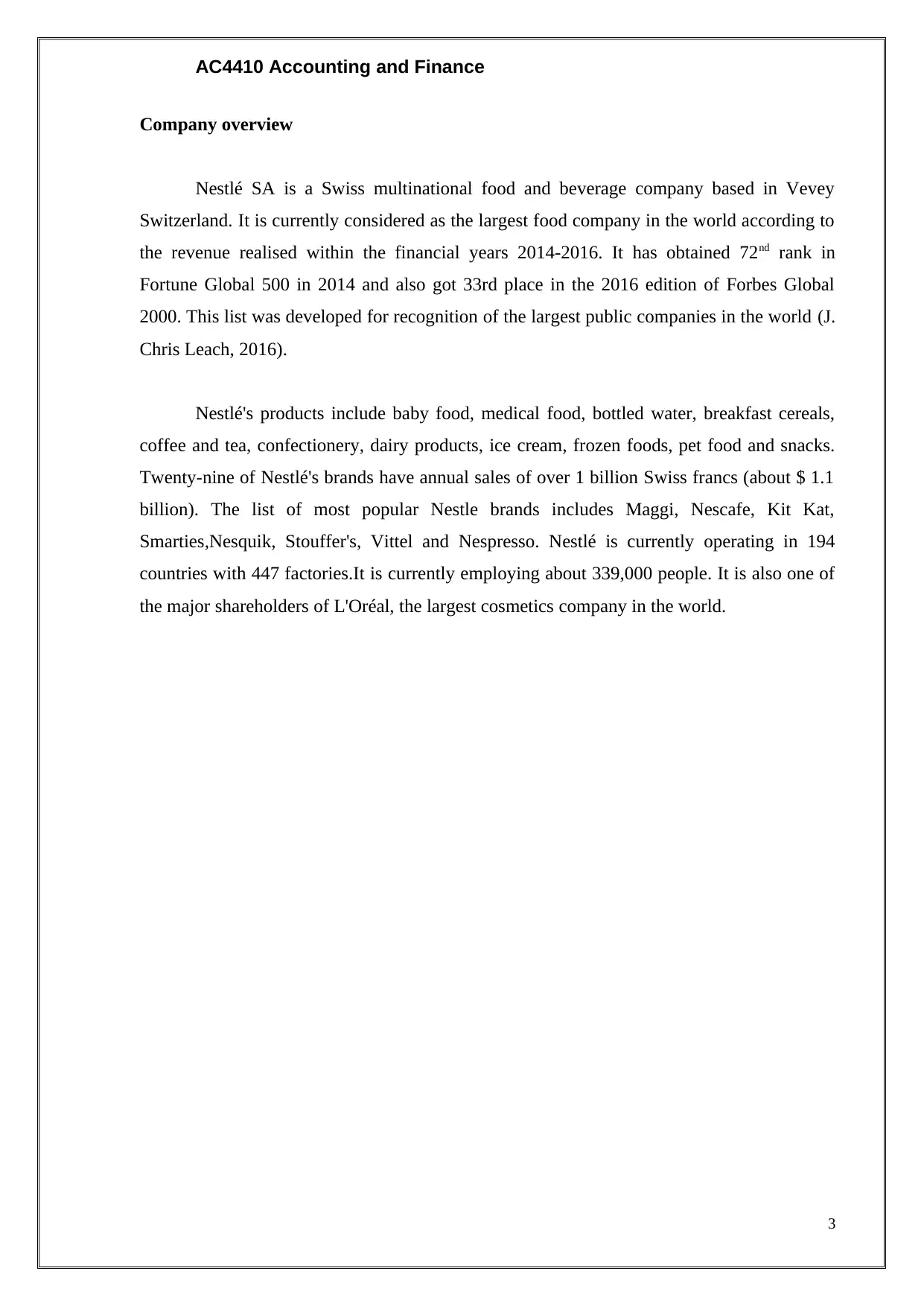
AC4410 Accounting and Finance
Company overview
Nestlé SA is a Swiss multinational food and beverage company based in Vevey
Switzerland. It is currently considered as the largest food company in the world according to
the revenue realised within the financial years 2014-2016. It has obtained 72nd rank in
Fortune Global 500 in 2014 and also got 33rd place in the 2016 edition of Forbes Global
2000. This list was developed for recognition of the largest public companies in the world (J.
Chris Leach, 2016).
Nestlé's products include baby food, medical food, bottled water, breakfast cereals,
coffee and tea, confectionery, dairy products, ice cream, frozen foods, pet food and snacks.
Twenty-nine of Nestlé's brands have annual sales of over 1 billion Swiss francs (about $ 1.1
billion). The list of most popular Nestle brands includes Maggi, Nescafe, Kit Kat,
Smarties,Nesquik, Stouffer's, Vittel and Nespresso. Nestlé is currently operating in 194
countries with 447 factories.It is currently employing about 339,000 people. It is also one of
the major shareholders of L'Oréal, the largest cosmetics company in the world.
3
Company overview
Nestlé SA is a Swiss multinational food and beverage company based in Vevey
Switzerland. It is currently considered as the largest food company in the world according to
the revenue realised within the financial years 2014-2016. It has obtained 72nd rank in
Fortune Global 500 in 2014 and also got 33rd place in the 2016 edition of Forbes Global
2000. This list was developed for recognition of the largest public companies in the world (J.
Chris Leach, 2016).
Nestlé's products include baby food, medical food, bottled water, breakfast cereals,
coffee and tea, confectionery, dairy products, ice cream, frozen foods, pet food and snacks.
Twenty-nine of Nestlé's brands have annual sales of over 1 billion Swiss francs (about $ 1.1
billion). The list of most popular Nestle brands includes Maggi, Nescafe, Kit Kat,
Smarties,Nesquik, Stouffer's, Vittel and Nespresso. Nestlé is currently operating in 194
countries with 447 factories.It is currently employing about 339,000 people. It is also one of
the major shareholders of L'Oréal, the largest cosmetics company in the world.
3
⊘ This is a preview!⊘
Do you want full access?
Subscribe today to unlock all pages.

Trusted by 1+ million students worldwide
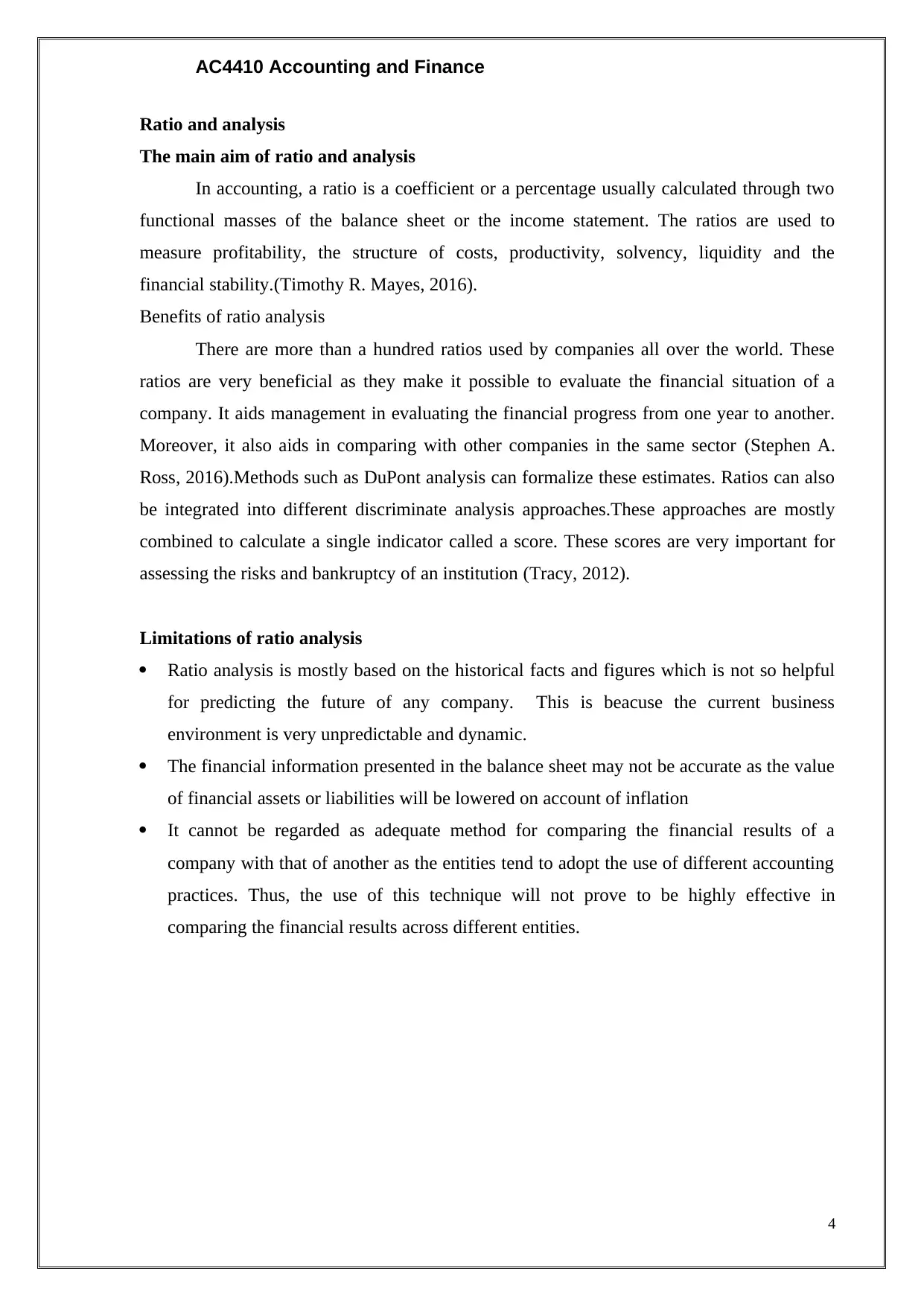
AC4410 Accounting and Finance
Ratio and analysis
The main aim of ratio and analysis
In accounting, a ratio is a coefficient or a percentage usually calculated through two
functional masses of the balance sheet or the income statement. The ratios are used to
measure profitability, the structure of costs, productivity, solvency, liquidity and the
financial stability.(Timothy R. Mayes, 2016).
Benefits of ratio analysis
There are more than a hundred ratios used by companies all over the world. These
ratios are very beneficial as they make it possible to evaluate the financial situation of a
company. It aids management in evaluating the financial progress from one year to another.
Moreover, it also aids in comparing with other companies in the same sector (Stephen A.
Ross, 2016).Methods such as DuPont analysis can formalize these estimates. Ratios can also
be integrated into different discriminate analysis approaches.These approaches are mostly
combined to calculate a single indicator called a score. These scores are very important for
assessing the risks and bankruptcy of an institution (Tracy, 2012).
Limitations of ratio analysis
Ratio analysis is mostly based on the historical facts and figures which is not so helpful
for predicting the future of any company. This is beacuse the current business
environment is very unpredictable and dynamic.
The financial information presented in the balance sheet may not be accurate as the value
of financial assets or liabilities will be lowered on account of inflation
It cannot be regarded as adequate method for comparing the financial results of a
company with that of another as the entities tend to adopt the use of different accounting
practices. Thus, the use of this technique will not prove to be highly effective in
comparing the financial results across different entities.
4
Ratio and analysis
The main aim of ratio and analysis
In accounting, a ratio is a coefficient or a percentage usually calculated through two
functional masses of the balance sheet or the income statement. The ratios are used to
measure profitability, the structure of costs, productivity, solvency, liquidity and the
financial stability.(Timothy R. Mayes, 2016).
Benefits of ratio analysis
There are more than a hundred ratios used by companies all over the world. These
ratios are very beneficial as they make it possible to evaluate the financial situation of a
company. It aids management in evaluating the financial progress from one year to another.
Moreover, it also aids in comparing with other companies in the same sector (Stephen A.
Ross, 2016).Methods such as DuPont analysis can formalize these estimates. Ratios can also
be integrated into different discriminate analysis approaches.These approaches are mostly
combined to calculate a single indicator called a score. These scores are very important for
assessing the risks and bankruptcy of an institution (Tracy, 2012).
Limitations of ratio analysis
Ratio analysis is mostly based on the historical facts and figures which is not so helpful
for predicting the future of any company. This is beacuse the current business
environment is very unpredictable and dynamic.
The financial information presented in the balance sheet may not be accurate as the value
of financial assets or liabilities will be lowered on account of inflation
It cannot be regarded as adequate method for comparing the financial results of a
company with that of another as the entities tend to adopt the use of different accounting
practices. Thus, the use of this technique will not prove to be highly effective in
comparing the financial results across different entities.
4
Paraphrase This Document
Need a fresh take? Get an instant paraphrase of this document with our AI Paraphraser
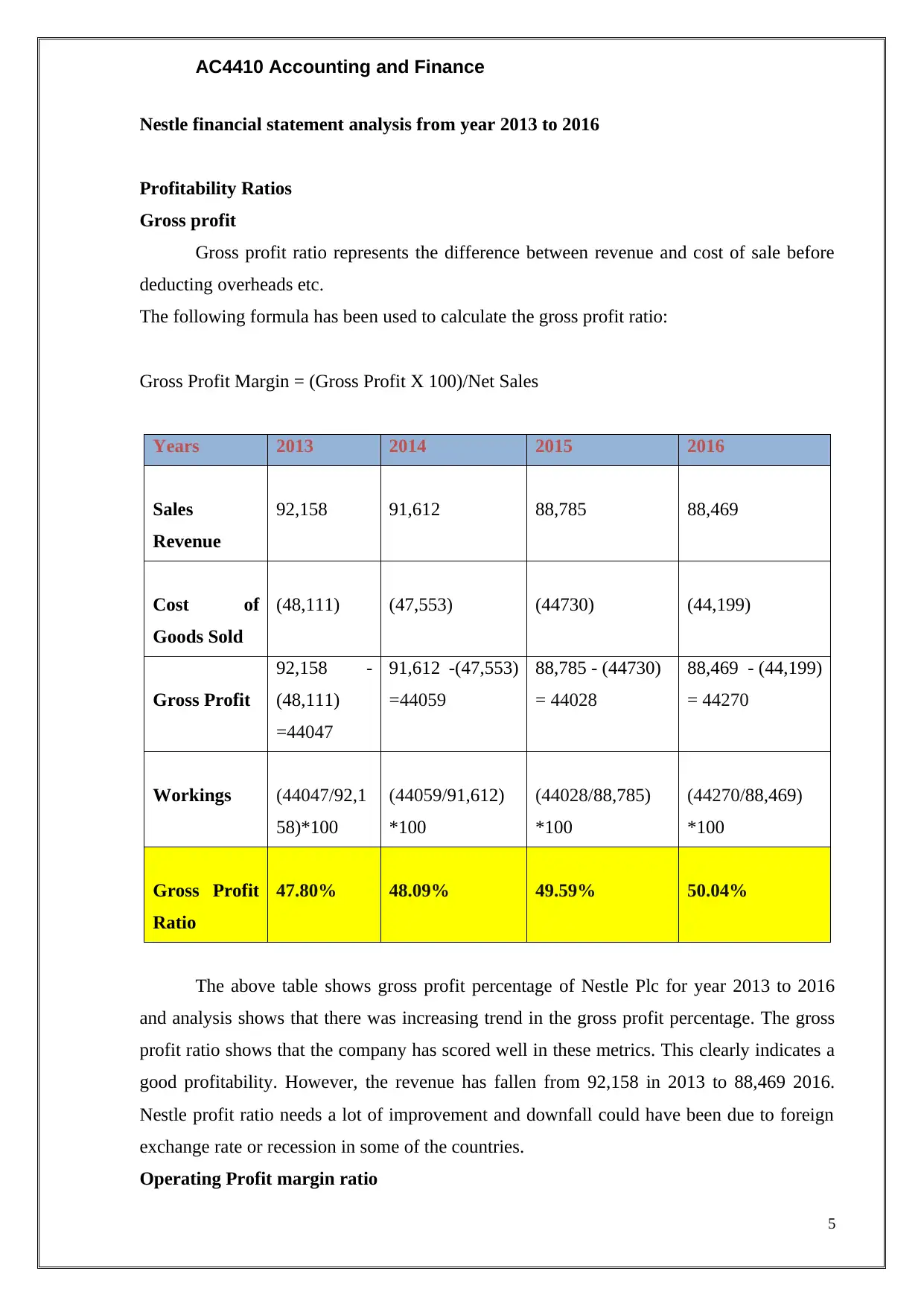
AC4410 Accounting and Finance
Nestle financial statement analysis from year 2013 to 2016
Profitability Ratios
Gross profit
Gross profit ratio represents the difference between revenue and cost of sale before
deducting overheads etc.
The following formula has been used to calculate the gross profit ratio:
Gross Profit Margin = (Gross Profit X 100)/Net Sales
Years 2013 2014 2015 2016
Sales
Revenue
92,158 91,612 88,785 88,469
Cost of
Goods Sold
(48,111) (47,553) (44730) (44,199)
Gross Profit
92,158 -
(48,111)
=44047
91,612 -(47,553)
=44059
88,785 - (44730)
= 44028
88,469 - (44,199)
= 44270
Workings (44047/92,1
58)*100
(44059/91,612)
*100
(44028/88,785)
*100
(44270/88,469)
*100
Gross Profit
Ratio
47.80% 48.09% 49.59% 50.04%
The above table shows gross profit percentage of Nestle Plc for year 2013 to 2016
and analysis shows that there was increasing trend in the gross profit percentage. The gross
profit ratio shows that the company has scored well in these metrics. This clearly indicates a
good profitability. However, the revenue has fallen from 92,158 in 2013 to 88,469 2016.
Nestle profit ratio needs a lot of improvement and downfall could have been due to foreign
exchange rate or recession in some of the countries.
Operating Profit margin ratio
5
Nestle financial statement analysis from year 2013 to 2016
Profitability Ratios
Gross profit
Gross profit ratio represents the difference between revenue and cost of sale before
deducting overheads etc.
The following formula has been used to calculate the gross profit ratio:
Gross Profit Margin = (Gross Profit X 100)/Net Sales
Years 2013 2014 2015 2016
Sales
Revenue
92,158 91,612 88,785 88,469
Cost of
Goods Sold
(48,111) (47,553) (44730) (44,199)
Gross Profit
92,158 -
(48,111)
=44047
91,612 -(47,553)
=44059
88,785 - (44730)
= 44028
88,469 - (44,199)
= 44270
Workings (44047/92,1
58)*100
(44059/91,612)
*100
(44028/88,785)
*100
(44270/88,469)
*100
Gross Profit
Ratio
47.80% 48.09% 49.59% 50.04%
The above table shows gross profit percentage of Nestle Plc for year 2013 to 2016
and analysis shows that there was increasing trend in the gross profit percentage. The gross
profit ratio shows that the company has scored well in these metrics. This clearly indicates a
good profitability. However, the revenue has fallen from 92,158 in 2013 to 88,469 2016.
Nestle profit ratio needs a lot of improvement and downfall could have been due to foreign
exchange rate or recession in some of the countries.
Operating Profit margin ratio
5
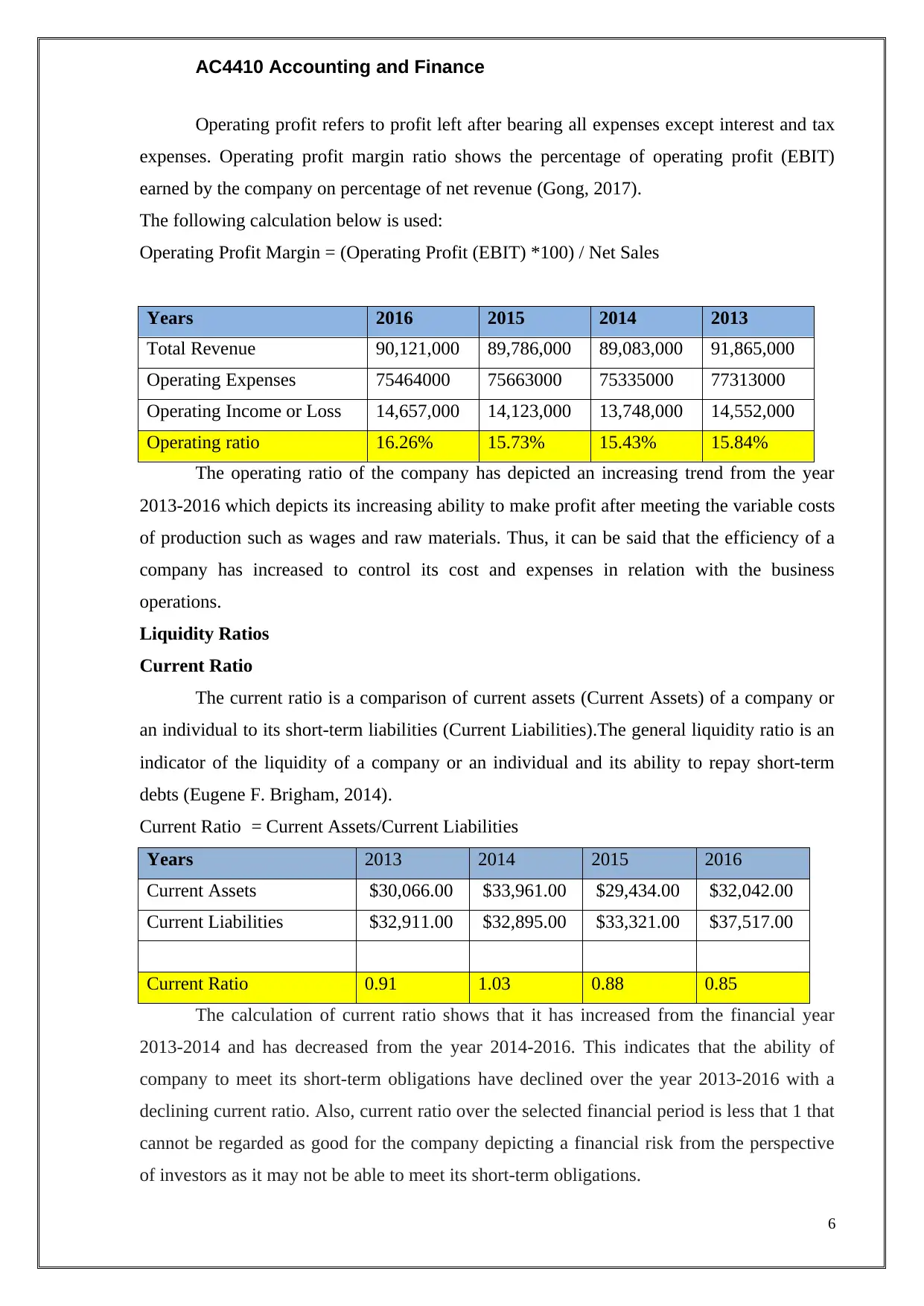
AC4410 Accounting and Finance
Operating profit refers to profit left after bearing all expenses except interest and tax
expenses. Operating profit margin ratio shows the percentage of operating profit (EBIT)
earned by the company on percentage of net revenue (Gong, 2017).
The following calculation below is used:
Operating Profit Margin = (Operating Profit (EBIT) *100) / Net Sales
Years 2016 2015 2014 2013
Total Revenue 90,121,000 89,786,000 89,083,000 91,865,000
Operating Expenses 75464000 75663000 75335000 77313000
Operating Income or Loss 14,657,000 14,123,000 13,748,000 14,552,000
Operating ratio 16.26% 15.73% 15.43% 15.84%
The operating ratio of the company has depicted an increasing trend from the year
2013-2016 which depicts its increasing ability to make profit after meeting the variable costs
of production such as wages and raw materials. Thus, it can be said that the efficiency of a
company has increased to control its cost and expenses in relation with the business
operations.
Liquidity Ratios
Current Ratio
The current ratio is a comparison of current assets (Current Assets) of a company or
an individual to its short-term liabilities (Current Liabilities).The general liquidity ratio is an
indicator of the liquidity of a company or an individual and its ability to repay short-term
debts (Eugene F. Brigham, 2014).
Current Ratio = Current Assets/Current Liabilities
Years 2013 2014 2015 2016
Current Assets $30,066.00 $33,961.00 $29,434.00 $32,042.00
Current Liabilities $32,911.00 $32,895.00 $33,321.00 $37,517.00
Current Ratio 0.91 1.03 0.88 0.85
The calculation of current ratio shows that it has increased from the financial year
2013-2014 and has decreased from the year 2014-2016. This indicates that the ability of
company to meet its short-term obligations have declined over the year 2013-2016 with a
declining current ratio. Also, current ratio over the selected financial period is less that 1 that
cannot be regarded as good for the company depicting a financial risk from the perspective
of investors as it may not be able to meet its short-term obligations.
6
Operating profit refers to profit left after bearing all expenses except interest and tax
expenses. Operating profit margin ratio shows the percentage of operating profit (EBIT)
earned by the company on percentage of net revenue (Gong, 2017).
The following calculation below is used:
Operating Profit Margin = (Operating Profit (EBIT) *100) / Net Sales
Years 2016 2015 2014 2013
Total Revenue 90,121,000 89,786,000 89,083,000 91,865,000
Operating Expenses 75464000 75663000 75335000 77313000
Operating Income or Loss 14,657,000 14,123,000 13,748,000 14,552,000
Operating ratio 16.26% 15.73% 15.43% 15.84%
The operating ratio of the company has depicted an increasing trend from the year
2013-2016 which depicts its increasing ability to make profit after meeting the variable costs
of production such as wages and raw materials. Thus, it can be said that the efficiency of a
company has increased to control its cost and expenses in relation with the business
operations.
Liquidity Ratios
Current Ratio
The current ratio is a comparison of current assets (Current Assets) of a company or
an individual to its short-term liabilities (Current Liabilities).The general liquidity ratio is an
indicator of the liquidity of a company or an individual and its ability to repay short-term
debts (Eugene F. Brigham, 2014).
Current Ratio = Current Assets/Current Liabilities
Years 2013 2014 2015 2016
Current Assets $30,066.00 $33,961.00 $29,434.00 $32,042.00
Current Liabilities $32,911.00 $32,895.00 $33,321.00 $37,517.00
Current Ratio 0.91 1.03 0.88 0.85
The calculation of current ratio shows that it has increased from the financial year
2013-2014 and has decreased from the year 2014-2016. This indicates that the ability of
company to meet its short-term obligations have declined over the year 2013-2016 with a
declining current ratio. Also, current ratio over the selected financial period is less that 1 that
cannot be regarded as good for the company depicting a financial risk from the perspective
of investors as it may not be able to meet its short-term obligations.
6
⊘ This is a preview!⊘
Do you want full access?
Subscribe today to unlock all pages.

Trusted by 1+ million students worldwide
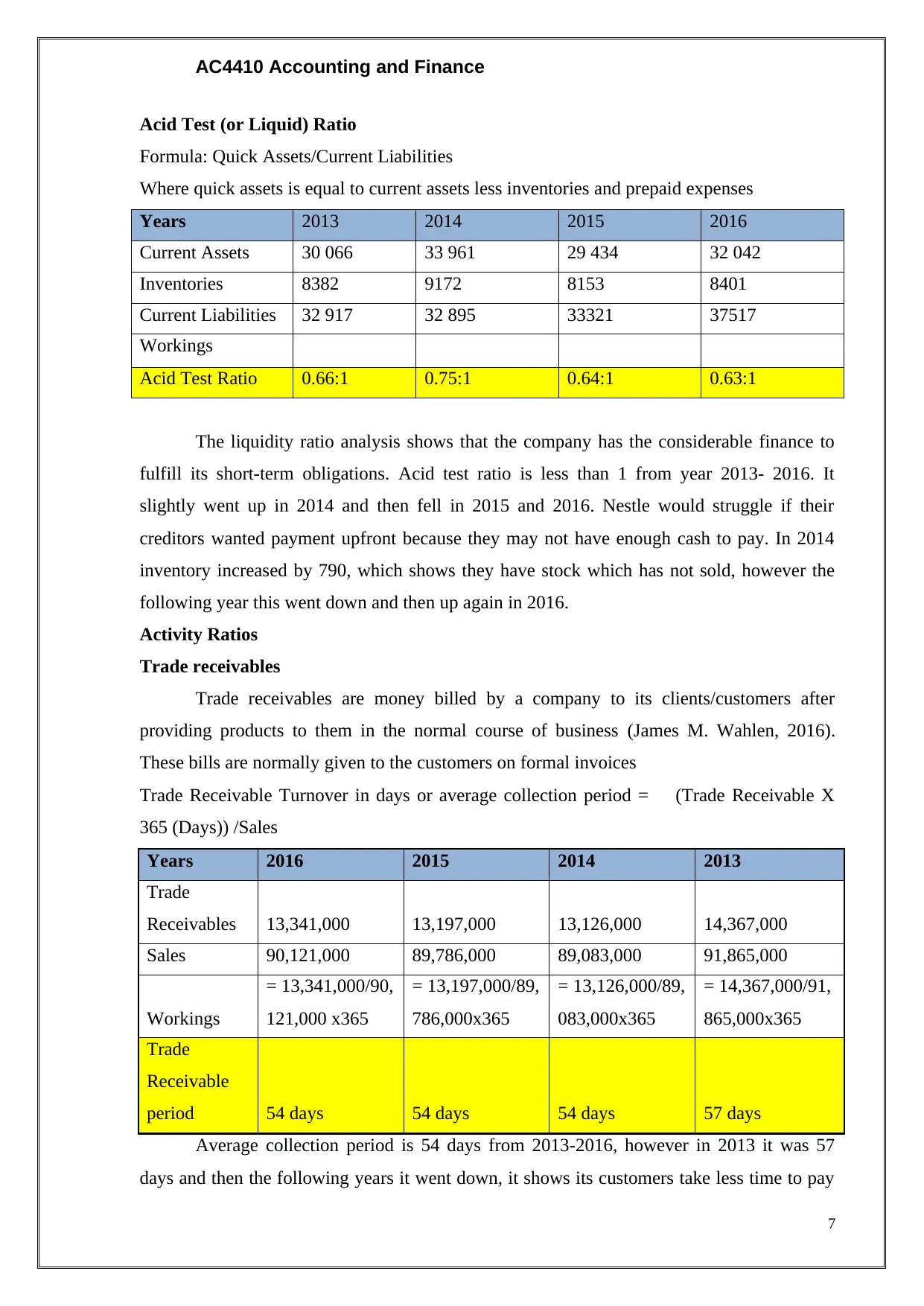
AC4410 Accounting and Finance
Acid Test (or Liquid) Ratio
Formula: Quick Assets/Current Liabilities
Where quick assets is equal to current assets less inventories and prepaid expenses
Years 2013 2014 2015 2016
Current Assets 30 066 33 961 29 434 32 042
Inventories 8382 9172 8153 8401
Current Liabilities 32 917 32 895 33321 37517
Workings
Acid Test Ratio 0.66:1 0.75:1 0.64:1 0.63:1
The liquidity ratio analysis shows that the company has the considerable finance to
fulfill its short-term obligations. Acid test ratio is less than 1 from year 2013- 2016. It
slightly went up in 2014 and then fell in 2015 and 2016. Nestle would struggle if their
creditors wanted payment upfront because they may not have enough cash to pay. In 2014
inventory increased by 790, which shows they have stock which has not sold, however the
following year this went down and then up again in 2016.
Activity Ratios
Trade receivables
Trade receivables are money billed by a company to its clients/customers after
providing products to them in the normal course of business (James M. Wahlen, 2016).
These bills are normally given to the customers on formal invoices
Trade Receivable Turnover in days or average collection period = (Trade Receivable X
365 (Days)) /Sales
Years 2016 2015 2014 2013
Trade
Receivables 13,341,000 13,197,000 13,126,000 14,367,000
Sales 90,121,000 89,786,000 89,083,000 91,865,000
Workings
= 13,341,000/90,
121,000 x365
= 13,197,000/89,
786,000x365
= 13,126,000/89,
083,000x365
= 14,367,000/91,
865,000x365
Trade
Receivable
period 54 days 54 days 54 days 57 days
Average collection period is 54 days from 2013-2016, however in 2013 it was 57
days and then the following years it went down, it shows its customers take less time to pay
7
Acid Test (or Liquid) Ratio
Formula: Quick Assets/Current Liabilities
Where quick assets is equal to current assets less inventories and prepaid expenses
Years 2013 2014 2015 2016
Current Assets 30 066 33 961 29 434 32 042
Inventories 8382 9172 8153 8401
Current Liabilities 32 917 32 895 33321 37517
Workings
Acid Test Ratio 0.66:1 0.75:1 0.64:1 0.63:1
The liquidity ratio analysis shows that the company has the considerable finance to
fulfill its short-term obligations. Acid test ratio is less than 1 from year 2013- 2016. It
slightly went up in 2014 and then fell in 2015 and 2016. Nestle would struggle if their
creditors wanted payment upfront because they may not have enough cash to pay. In 2014
inventory increased by 790, which shows they have stock which has not sold, however the
following year this went down and then up again in 2016.
Activity Ratios
Trade receivables
Trade receivables are money billed by a company to its clients/customers after
providing products to them in the normal course of business (James M. Wahlen, 2016).
These bills are normally given to the customers on formal invoices
Trade Receivable Turnover in days or average collection period = (Trade Receivable X
365 (Days)) /Sales
Years 2016 2015 2014 2013
Trade
Receivables 13,341,000 13,197,000 13,126,000 14,367,000
Sales 90,121,000 89,786,000 89,083,000 91,865,000
Workings
= 13,341,000/90,
121,000 x365
= 13,197,000/89,
786,000x365
= 13,126,000/89,
083,000x365
= 14,367,000/91,
865,000x365
Trade
Receivable
period 54 days 54 days 54 days 57 days
Average collection period is 54 days from 2013-2016, however in 2013 it was 57
days and then the following years it went down, it shows its customers take less time to pay
7
Paraphrase This Document
Need a fresh take? Get an instant paraphrase of this document with our AI Paraphraser

AC4410 Accounting and Finance
back compared to 2013. Another reason for longer time frame in 2013 is because trade
receivable was higher than the other three years.
Trade Payable
Trade payable is also known as accounts payable. This is the amount payable to a
supplier for raw material delivered to the company. The due amount is billed by the supplier
on the given credit terms.
Trade Payable Turnover in days = (Trade Payable * 365 (Days)) / Cost of Goods Sold
Years 2013 2014 2015 2016
Trade
payable
16072 17473 17038 18629
Cost of
goods
sold
(48,111) (47,553) (44730) (44,199)
Working
s
16072/
(48,111)*365
17473/
(47,553)*365
17038/
(44730)*365
18629/
(44,199)*365
Trade
payable
Period
121.93 134.16 139.03 153.84
Trade payable has gone up slightly each year from 2013-2016, the reason for trade
payable has gone could be due to cost of goods has fallen.
Conclusion
Nestle company must reduce its expenses to increase its overall profitability.It must
also improve its revenue model to generate more sales through its sales teams. Nestle must
also increase its product line by using cross-selling strategies. Nestle has to switch to a
relationship based model through which it can easily attract its lost customers. It can also
improve its and profitability through incentivizing new customers to try its new and latest
products with short-term giveaways, specials deals, and discounts.
8
back compared to 2013. Another reason for longer time frame in 2013 is because trade
receivable was higher than the other three years.
Trade Payable
Trade payable is also known as accounts payable. This is the amount payable to a
supplier for raw material delivered to the company. The due amount is billed by the supplier
on the given credit terms.
Trade Payable Turnover in days = (Trade Payable * 365 (Days)) / Cost of Goods Sold
Years 2013 2014 2015 2016
Trade
payable
16072 17473 17038 18629
Cost of
goods
sold
(48,111) (47,553) (44730) (44,199)
Working
s
16072/
(48,111)*365
17473/
(47,553)*365
17038/
(44730)*365
18629/
(44,199)*365
Trade
payable
Period
121.93 134.16 139.03 153.84
Trade payable has gone up slightly each year from 2013-2016, the reason for trade
payable has gone could be due to cost of goods has fallen.
Conclusion
Nestle company must reduce its expenses to increase its overall profitability.It must
also improve its revenue model to generate more sales through its sales teams. Nestle must
also increase its product line by using cross-selling strategies. Nestle has to switch to a
relationship based model through which it can easily attract its lost customers. It can also
improve its and profitability through incentivizing new customers to try its new and latest
products with short-term giveaways, specials deals, and discounts.
8
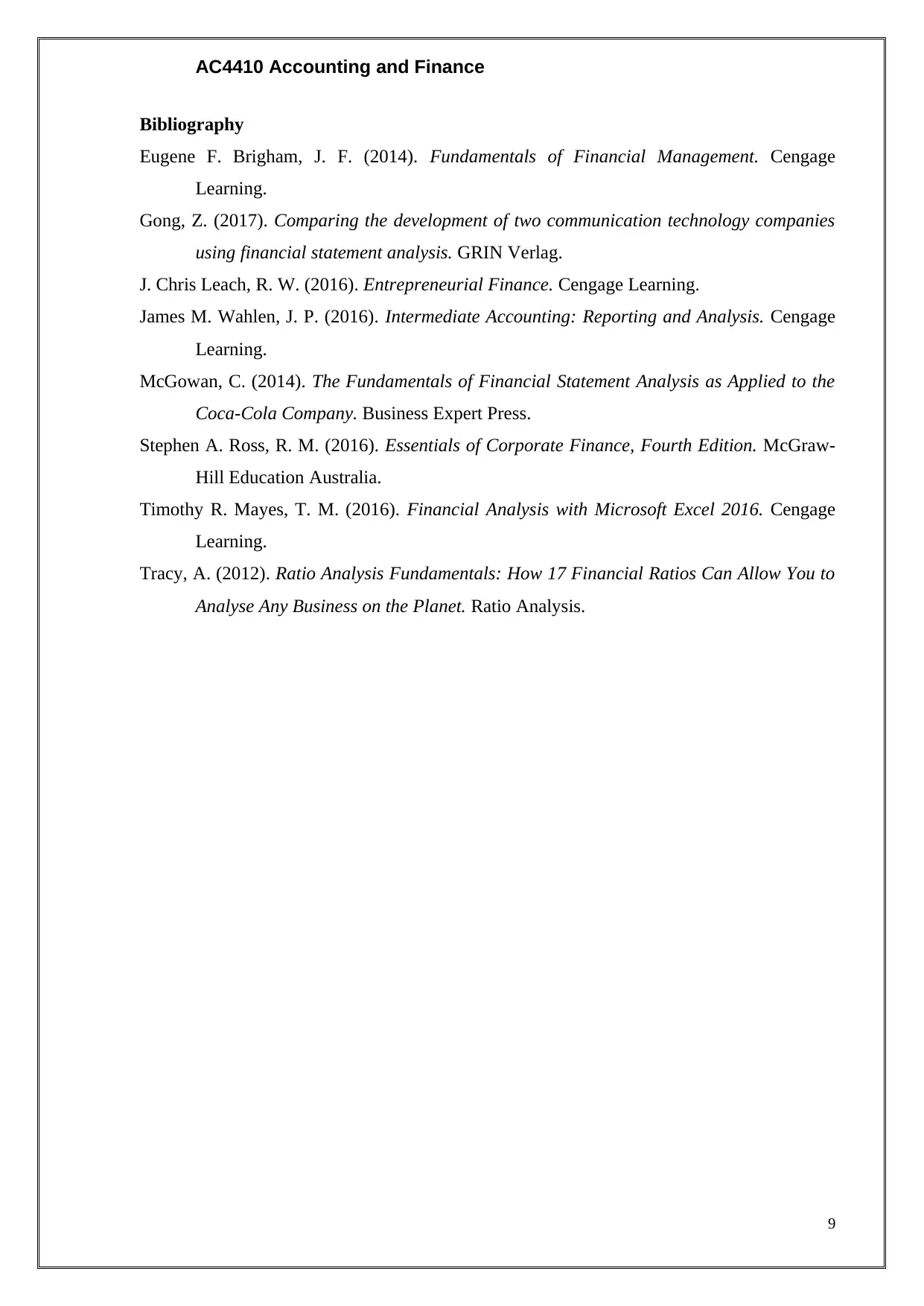
AC4410 Accounting and Finance
Bibliography
Eugene F. Brigham, J. F. (2014). Fundamentals of Financial Management. Cengage
Learning.
Gong, Z. (2017). Comparing the development of two communication technology companies
using financial statement analysis. GRIN Verlag.
J. Chris Leach, R. W. (2016). Entrepreneurial Finance. Cengage Learning.
James M. Wahlen, J. P. (2016). Intermediate Accounting: Reporting and Analysis. Cengage
Learning.
McGowan, C. (2014). The Fundamentals of Financial Statement Analysis as Applied to the
Coca-Cola Company. Business Expert Press.
Stephen A. Ross, R. M. (2016). Essentials of Corporate Finance, Fourth Edition. McGraw-
Hill Education Australia.
Timothy R. Mayes, T. M. (2016). Financial Analysis with Microsoft Excel 2016. Cengage
Learning.
Tracy, A. (2012). Ratio Analysis Fundamentals: How 17 Financial Ratios Can Allow You to
Analyse Any Business on the Planet. Ratio Analysis.
9
Bibliography
Eugene F. Brigham, J. F. (2014). Fundamentals of Financial Management. Cengage
Learning.
Gong, Z. (2017). Comparing the development of two communication technology companies
using financial statement analysis. GRIN Verlag.
J. Chris Leach, R. W. (2016). Entrepreneurial Finance. Cengage Learning.
James M. Wahlen, J. P. (2016). Intermediate Accounting: Reporting and Analysis. Cengage
Learning.
McGowan, C. (2014). The Fundamentals of Financial Statement Analysis as Applied to the
Coca-Cola Company. Business Expert Press.
Stephen A. Ross, R. M. (2016). Essentials of Corporate Finance, Fourth Edition. McGraw-
Hill Education Australia.
Timothy R. Mayes, T. M. (2016). Financial Analysis with Microsoft Excel 2016. Cengage
Learning.
Tracy, A. (2012). Ratio Analysis Fundamentals: How 17 Financial Ratios Can Allow You to
Analyse Any Business on the Planet. Ratio Analysis.
9
⊘ This is a preview!⊘
Do you want full access?
Subscribe today to unlock all pages.

Trusted by 1+ million students worldwide
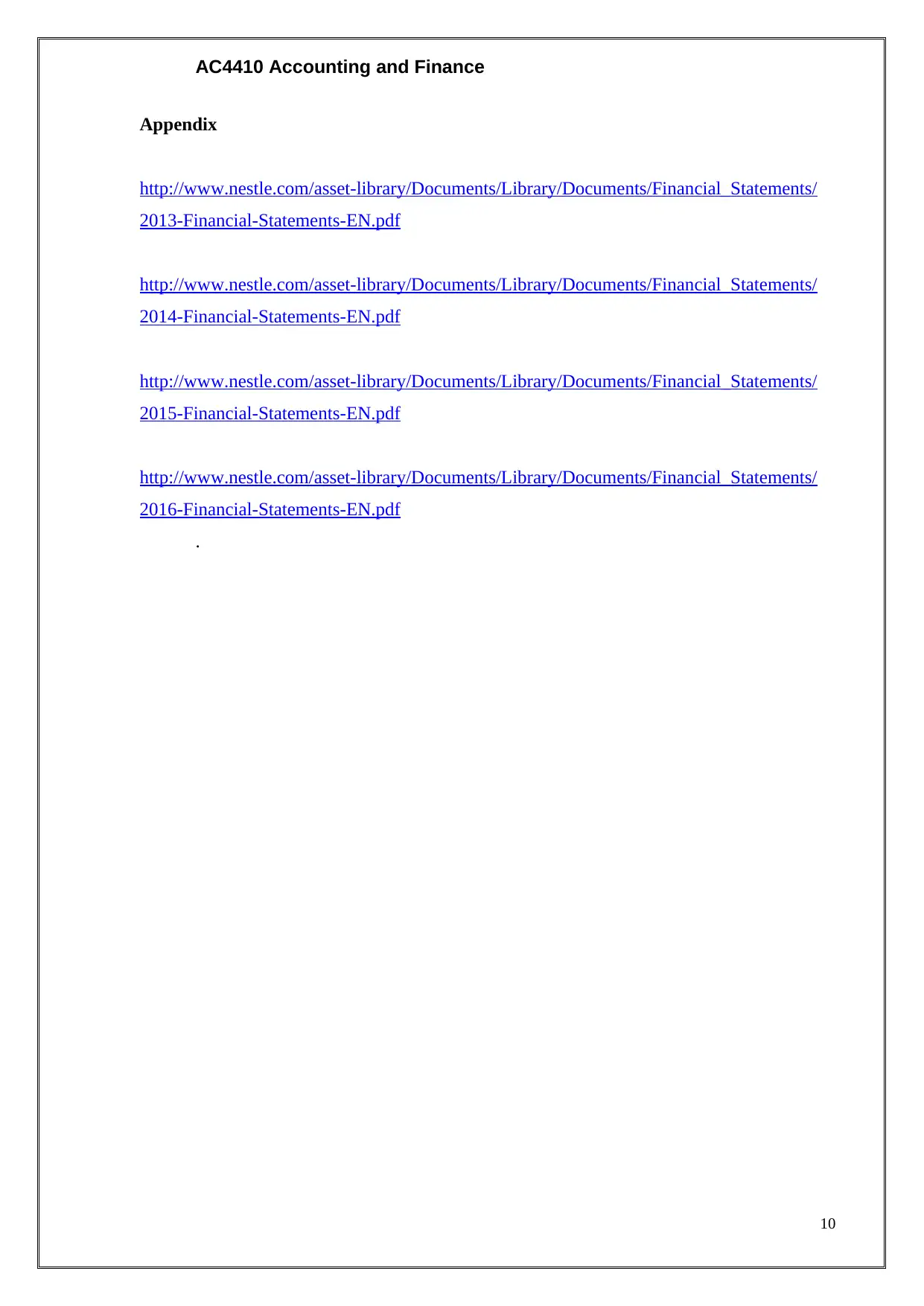
AC4410 Accounting and Finance
Appendix
http://www.nestle.com/asset-library/Documents/Library/Documents/Financial_Statements/
2013-Financial-Statements-EN.pdf
http://www.nestle.com/asset-library/Documents/Library/Documents/Financial_Statements/
2014-Financial-Statements-EN.pdf
http://www.nestle.com/asset-library/Documents/Library/Documents/Financial_Statements/
2015-Financial-Statements-EN.pdf
http://www.nestle.com/asset-library/Documents/Library/Documents/Financial_Statements/
2016-Financial-Statements-EN.pdf
.
10
Appendix
http://www.nestle.com/asset-library/Documents/Library/Documents/Financial_Statements/
2013-Financial-Statements-EN.pdf
http://www.nestle.com/asset-library/Documents/Library/Documents/Financial_Statements/
2014-Financial-Statements-EN.pdf
http://www.nestle.com/asset-library/Documents/Library/Documents/Financial_Statements/
2015-Financial-Statements-EN.pdf
http://www.nestle.com/asset-library/Documents/Library/Documents/Financial_Statements/
2016-Financial-Statements-EN.pdf
.
10
1 out of 10
Related Documents
Your All-in-One AI-Powered Toolkit for Academic Success.
+13062052269
info@desklib.com
Available 24*7 on WhatsApp / Email
![[object Object]](/_next/static/media/star-bottom.7253800d.svg)
Unlock your academic potential
© 2024 | Zucol Services PVT LTD | All rights reserved.





